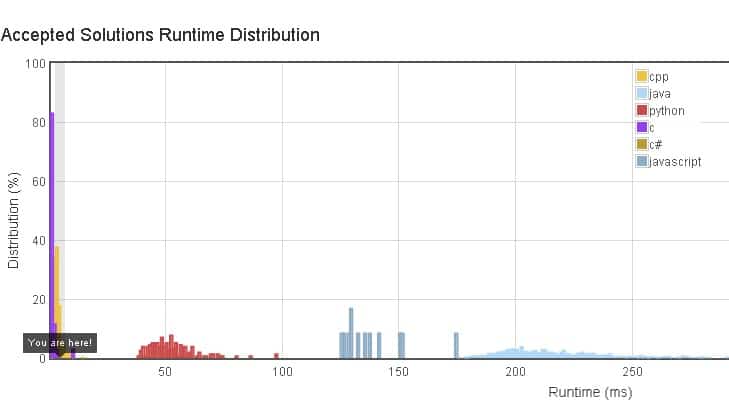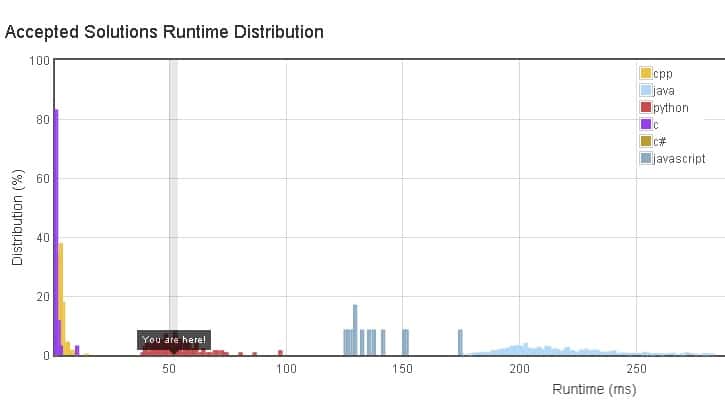Given an index k, return the k-th row of the Pascal’s triangle.
For example, given k = 3,
Return [1,3,3,1].
Could you optimize your algorithm to use only O(k) extra space?
C++ O(n^2) to Compute the Pascal Triangle
It is easy to know that each number in the triangle equals to the sum of the two numbers of its shoulder if there are any.
1 2 3 4 5 6 7 8 9 10 11 12 13 14 15 16 17 18 19 | class Solution { public: vector<int> getRow(int rowIndex) { vector<int> r; if (rowIndex == 0) { r.push_back(1); return r; } r.resize(rowIndex + 1); r[0] = 1; r[1] = 1; for (int i = 0; i < rowIndex - 1; i ++) { for (int j = rowIndex; j > 0; j --) { r[j] += r[j - 1]; } } return r; } }; |
class Solution {
public:
vector<int> getRow(int rowIndex) {
vector<int> r;
if (rowIndex == 0) {
r.push_back(1);
return r;
}
r.resize(rowIndex + 1);
r[0] = 1;
r[1] = 1;
for (int i = 0; i < rowIndex - 1; i ++) {
for (int j = rowIndex; j > 0; j --) {
r[j] += r[j - 1];
}
}
return r;
}
};We don’t need to store two dimension pascal triangles as when we calculate the k-th row all we need is (k-1)-th row of numbers. We allocate rowIndex + 1 elements in the vector and set the first two elements to both ones. rowIndex = 0 is the special case so we need to return a vector that contains a single element 1 and return it.
Then for next rowIndex – 1 iterations, we sum from right to the left interactively. The C++ submission is fast.

c-plus-plus-pascal-triangle
The Python equivalence looks simpler:
1 2 3 4 5 6 7 8 9 10 11 12 | class Solution: # @return a list of integers def getRow(self, rowIndex): if rowIndex == 0: return [1] r = [0] * (rowIndex + 1) r[0] = 1 r[1] = 1 for i in range(rowIndex - 1): for j in range(rowIndex, 0, -1): r[j] = r[j] + r[j - 1] return r |
class Solution:
# @return a list of integers
def getRow(self, rowIndex):
if rowIndex == 0:
return [1]
r = [0] * (rowIndex + 1)
r[0] = 1
r[1] = 1
for i in range(rowIndex - 1):
for j in range(rowIndex, 0, -1):
r[j] = r[j] + r[j - 1]
return rBut python is generally slower in terms of performance.

python-submission
Compute the Pacal Triangle in C++ O(n) time O(k) space
Each line of Pascal’s Triangle is a full set of Combination number based on k .
1 | comb(k,p) = k! /( p! *(k-p)!) = comb(k,k-p) |
comb(k,p) = k! /( p! *(k-p)!) = comb(k,k-p)
if p < k-p
1 | comb(k,p) = comb(k,p-1) * (k-p+1) / p |
comb(k,p) = comb(k,p-1) * (k-p+1) / p
Because :
1 | comb(k,p) = [ k * (k-1) * (k-2) *... (k-p+1)] / [1 * 2 * 3 *...(p)] |
comb(k,p) = [ k * (k-1) * (k-2) *... (k-p+1)] / [1 * 2 * 3 *...(p)]
1 2 3 4 5 6 7 8 9 10 11 12 13 14 15 16 17 | class Solution { public: vector<int> getRow(int rowIndex) { vector<int> ans(rowIndex + 1, 1); int small = rowIndex / 2; long comb = 1; int j = 1; for (int i = rowIndex; i >= small; i--){ comb *= i; comb /= j; j ++; ans[i-1] = (int)comb; ans[j-1] = (int)comb; } return ans; } }; |
class Solution {
public:
vector<int> getRow(int rowIndex) {
vector<int> ans(rowIndex + 1, 1);
int small = rowIndex / 2;
long comb = 1;
int j = 1;
for (int i = rowIndex; i >= small; i--){
comb *= i;
comb /= j;
j ++;
ans[i-1] = (int)comb;
ans[j-1] = (int)comb;
}
return ans;
}
};This runs approximately two times faster (2ms) than the above O(n^2) solution. A similar solution gives also 2ms (calculate the first half of the array)
1 2 3 4 5 6 7 8 9 10 11 12 13 14 15 16 | class Solution { public: vector<int> getRow(int rowIndex) { vector<int> result(rowIndex + 1, 1); long current_multiplier = 1; for (int n = 1; n <= rowIndex / 2; ++n) { current_multiplier *= (rowIndex - n + 1); current_multiplier /= n; result[n] = current_multiplier; } for (int n = rowIndex / 2 + 1; n < rowIndex; ++n) { result[n] = result[rowIndex - n]; } return result; } }; |
class Solution {
public:
vector<int> getRow(int rowIndex) {
vector<int> result(rowIndex + 1, 1);
long current_multiplier = 1;
for (int n = 1; n <= rowIndex / 2; ++n) {
current_multiplier *= (rowIndex - n + 1);
current_multiplier /= n;
result[n] = current_multiplier;
}
for (int n = rowIndex / 2 + 1; n < rowIndex; ++n) {
result[n] = result[rowIndex - n];
}
return result;
}
};To compute the N-th row of a Pascal Triangle: You can use Dynamic Programming algorithm: Compute the Nth Row of a Pascal’s Triangle using Dynamic Programming Algorithm
Pascal Triangle Implementations:
- Teaching Kids Programming – Pascal Triangle Algorithms and Applications
- Coding Exercise – Pascal Triangle II – C++ and Python Solution
- How to Print Pascal Triangle in C++ (with Source Code)
- Compute the Nth Row of a Pascal’s Triangle using Dynamic Programming Algorithm
- GoLang: Generate a Pascal Triangle
–EOF (The Ultimate Computing & Technology Blog) —
loading...
Last Post: How to Search Twits with Pictures/Images using PHP?
Next Post: Linux Bash Coding Exercise - Get the Tenth Line of File